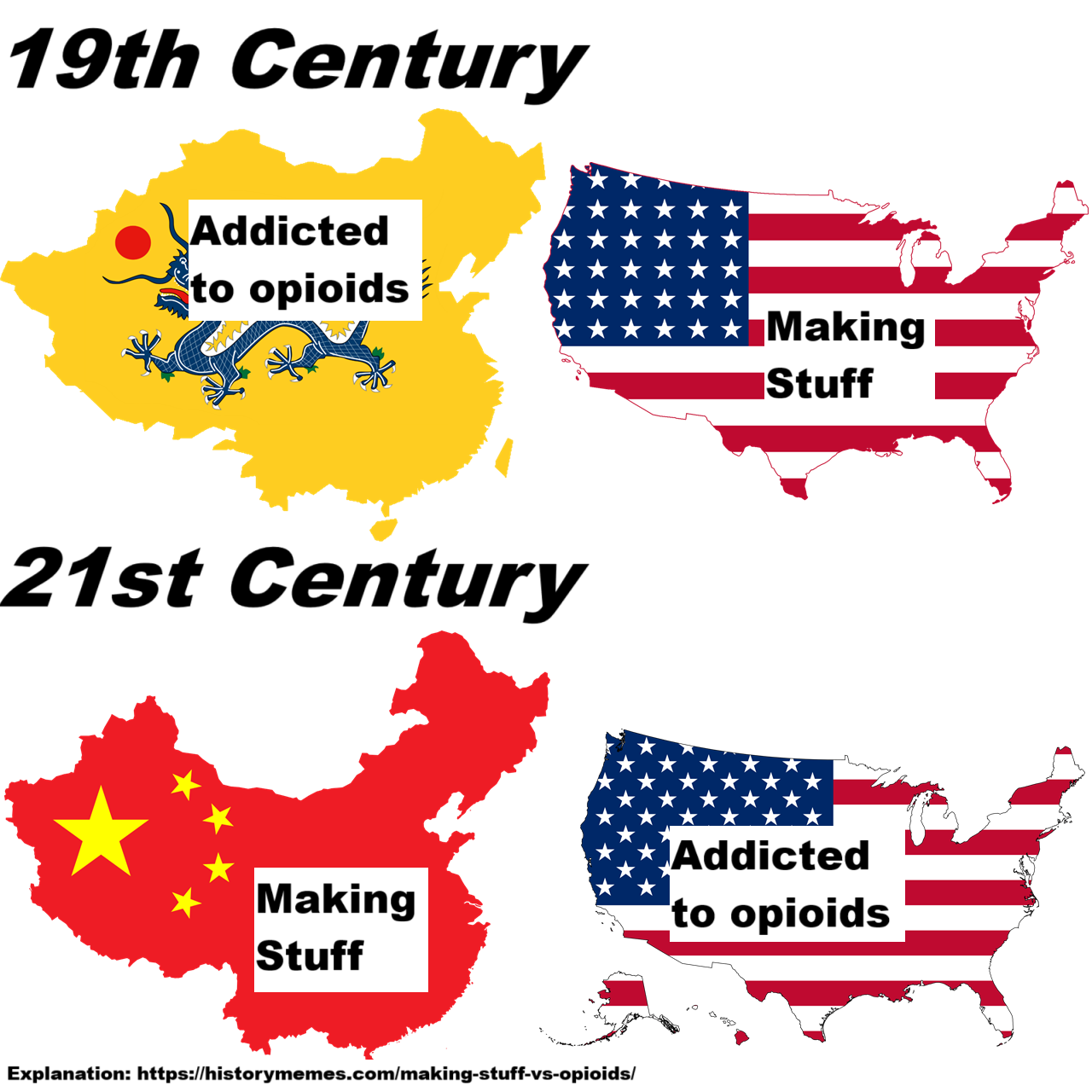
The map meme above shows the reversal of fortunes of both the United States & China between the 19th and 21st centuries.
Here’s a bit more of an explanation of you’re not familiar with the history.
19th Century: U.S. Manufacturing Growth vs. China’s Decline
United States (Industrial Growth):
- Early industrialization: In the early 1800s, the U.S. began transitioning from an agrarian economy to an industrial one. Key sectors included textiles, iron, and later steel, with factories concentrated in the Northeast.
- Transportation & infrastructure: The construction of canals, railroads, and steamships tied regional markets together and boosted both domestic and international trade.
- Innovation & scale: Inventions like the cotton gin, mechanized looms, and interchangeable parts (a hallmark of the “American System of Manufacturing“) increased productivity.
- Late 19th century boom: After the Civil War, the U.S. experienced explosive industrial growth: steel, oil, railroads, and consumer goods, making it one of the world’s leading manufacturing powers by 1900.
China (Relative Decline):
- Opium trade & addiction: Britain and later other Western powers forced China to accept massive imports of opium (primarily from British India). Addiction rates soared, draining silver reserves and undermining social stability.
- Opium Wars (1839–42, 1856–60): Military defeats forced China into “unequal treaties,” opening ports, ceding Hong Kong, and granting extraterritorial rights to foreigners.
- Economic stagnation: While China remained agriculturally productive, its traditional industries (like handicrafts and textiles) were undercut by Western imports. Silver outflows and indemnities further weakened the Qing economy.
- Political instability: Internal uprisings (Taiping, Nian, Boxer Rebellion) compounded the economic and social crises.
Result: The U.S. rose as a manufacturing powerhouse, while China suffered economic decline, political weakness, and humiliation at the hands of industrialized powers.
21st Century: Reversal of Fortunes
China (Manufacturing Boom):
- Economic reforms (post-1978): Deng Xiaoping’s “Reform and Opening Up” policies liberalized parts of the economy, encouraged foreign investment, and established Special Economic Zones.
- Global supply chain dominance: By the 2000s, China became “the world’s factory,” specializing in everything from cheap textiles to high-tech electronics.
- Export-driven growth: China leveraged low labor costs, scale, and infrastructure to dominate global exports, making it the largest manufacturer in the world by the 2010s.
- Moving up the value chain: Today, China is pushing into semiconductors, green tech, and AI, aiming to compete at the technological frontier.
United States (Relative Challenges):
- Deindustrialization: Since the 1970s, many U.S. manufacturing jobs moved overseas, especially to China. While high-tech industries remain strong, large-scale consumer goods production has declined.
- Opioid crisis: Beginning in the late 1990s, prescription painkillers (OxyContin, etc.) were overprescribed, leading to widespread addiction. This transitioned into heroin and fentanyl abuse, with devastating social consequences, particularly in former industrial regions hit hardest by job losses.
- Economic imbalance: The U.S. economy is still innovative and wealthy, but heavily dependent on services and imports, many from China.
Result: China is now the global manufacturing leader, while the U.S. struggles with social and health crises (opioids being a symbol), echoing the 19th-century reversal.
The Historical Irony
- 19th century: The U.S. built factories while China was flooded with opium.
- 21st century: China builds factories while the U.S. struggles with opioids.
It’s not a perfect mirror (the causes and contexts are different), but the symbolism is striking, a powerful cycle of industrial rise and social crisis trading places across centuries.
More books on the topics:
- Imperial Twilight: The Opium War and the End of China’s Last Golden Age
- From the American System to Mass Production, 1800-1932
- The Hundred-Year Marathon: China’s Secret Strategy to Replace America as the Global Superpower
- American Overdose: The Opioid Tragedy in Three Acts
What do you think?
Leave a Reply